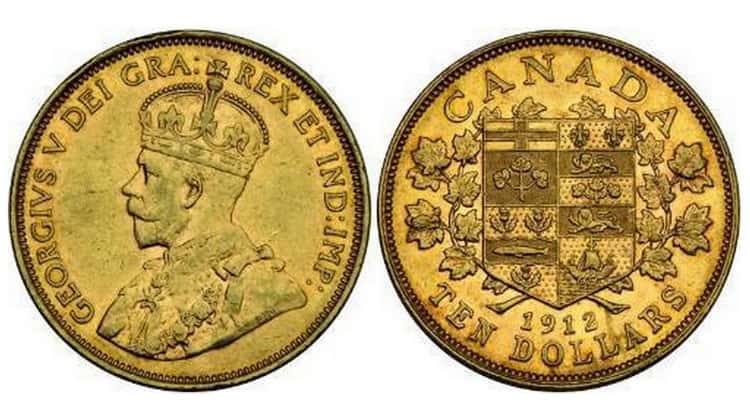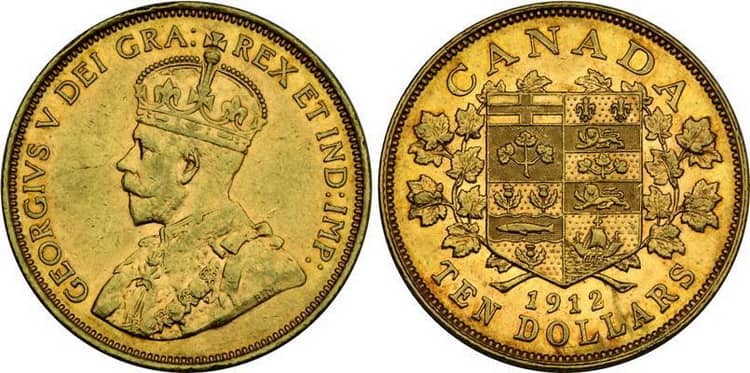
10 Canadian dollars (1912-1914) – a gold coin of regular issue minted by the order of the royal mint of George V. The production of these coins was completely stopped because of the outbreak of World War I when the Government of Canada withdrew most of the coins circulating around the country to finance the war. After the signing of the Versailles Treaty, the Ministry of Finance of Canada announced the reissue of these coins, but these plans were not destined to be implemented. In 1928, it was officially announced that the country does not plan to issue more gold coins of the regular issue.
Special features of Canadian coins design
Canadian coins have always been issued by the royal mint; however, the coinage is done at special plants in Winnipeg. Due to the two official languages, English and French, Canada produces all coins in two versions, with inscriptions in the relevant language. However, on commemorative, jubilee and collectible coins of special series, all standard formulations on the reverse side are usually chosen in the way that they are identical in both languages. All special formulations on the obverse of collectible coins, including the title and name of the ruling monarch, are engraved in abbreviated Latin. All Canadian gold coins in our catalog.
Currently, the inscription on the obverse of modern coins is “ELIZABETH II D. G. REGINA”. “D. G.” means “Dei Gratia”, and the whole phrase is translated into English as “Elizabeth II, Queen by the grace of God.” The only series of coins issued without the inscription “Dei Gratia” was dedicated to the 2010 Winter Olympic Games in Vancouver. On the coins of the series “CANADA ELIZABETH II” is engraved instead of “ELIZABETH II D. G. REGINA”.
Specifications of 10 Canadian dollar coins
Years of issue: 1912-1914
Metal: gold
Diameter: 26.92 mm
Weight: 16.72 g
Thickness: 2.08 mm
Edge: reeded
Type of coinage: regular issue
Designers: Edgar Bertram MacKennal (obverse), William Henry James Blakemore (reverse).
Circulation: 74,759 (1912); 149,232 (1913); 140,068 (1914).
The obverse of the coin depicts King George V in profile, above it there’s an inscription “George V, King by the grace of God.” On the reverse side of the coin, there is an image of a shield with the coat of arms of the Dominion of Canada, the inscription “Canada” is above it, and a denomination and year of issue at the bottom. All 10 Dollars Canadian gold coins in our catalog.

History of the Canadian Mint
The coins, designed for circulation in the province of Canada, were first produced in 1858. For the first fifty years, they were minted mostly at the royal mint in London, although some of the items were produced by a private mint in Birmingham. As Canada began to move towards its independence the need for coinage increased. As a result, in 1901, it was granted permission to build the first branch of the royal mint in Ottawa in 1901.
At the time of the opening, the plant employed about 60 people. Three years later, the Mint of Canada started experimenting with gold processing with electrolysis, having built its own analytical laboratory. This method proved to be too labor-consuming. In 1915, the mint introduced a new chlorination process, developed in Australia, to shorten the processing time and increase the capacity of gold processing. Since then, the mint plant has undergone a number of changes and extensions. The current gold processing is a combination of chlorination and electrolysis.
Over the years, the mint has used various processes to extract and sell silver, which was often found in rough gold, but in 2006 the mint opened a new modern factory that finally made processing silver possible.
In 1979, the building of the royal mint in Ottawa was declared the national historical monument of Canada, because the building represents the special approach of the federal government of using the Gothic Tudor style to create valuable architectural monuments in the capital of Canada. This style cannot be confused with any other style of the world.
The Mint factory in Ottawa is responsible for the production of collectible and commemorative coins, ingots in the form of coins, medals, and medallions. The company uses a successful combination of modern high-tech equipment and manual stamps, ensuring that each coin is a real work of art. The gold and silver processing enterprises, which belong to the mint, are also located in Ottawa, as well as a full-time team of advanced research engineers who are completely committed to the job.
Cost of coins
The majority of gold coins in denominations of $10 are kept in private collections. They are a great investment and collectible item. The rarest of them are coins of 1912, as they were issued with the minimum for a regular issue coinage. At online auctions, the coin of this denomination is sold at an average price of 510 – 3,200 dollars, depending on the year of minting, place, and country of sale. All 1858-2017 Confederation Canadian gold coins in our catalog.
Interesting facts
- Gold coins of the regular issue of five and ten dollars denominations were issued in Canada only during the described period of time – from 1912 to 1914. Earlier it was believed that the independent issue of the gold Canadian dollar would violate the “royal prerogative” and the government was forced to abandon the issue of its own currency from this precious metal, although some small circulations of sovereigns were minted for several years with the permission of the royal mint in England.
- The production of Canadian coins of the beginning of the reign of George V is often called “godless”, as the obverse of the first coins depicting the newly-made king did not contain the inscription “DEI GRA” (short for DEI GRATIA, “the king by the grace of God”), which was usually present on all coins of the kingdom from the very first one. An incredible scandal arose when an oversight (or special intent) of the minters was noticed– the citizens of the country didn`t want traditions of Canadian coinage to be violated, regardless of their own opinion of the king. The inscription had to be returned, so they withdrew all the coins from the circulation. Literally, all coins with a face value of 1 to 50 cents were re-issued, but some of them can still be found in the hands of collectors and private investors. All 1 Cent and 50 Cent Canadian gold coins in our catalog.
- According to the Royal Canadian Mint, a large number of gold coins from 1912-1914 were kept in the National Bank of Canada for more than 75 years. In 2012, the mint offered 30,000 coins from this collection for a free sale through its own retail channels. It was also announced that the remaining coins with the quantity of 245,000 copies will be melted into ingots, and then submitted for sale at auctions.
The first Canadian commemorative coin was issued in 1935 to commemorate the silver jubilee of King George V reign. The King’s portrait on this coin was the same as on the coins of some other countries. This coin also features a famous design called “coureur des bois”, which was created by the renowned Emmanuelle Khanh. Like other coins designed by Emmanuelle Khanh, this coin has a special nickname – “voyageur dollar” (“traveler’s dollar”).
Comments
No commens yet.